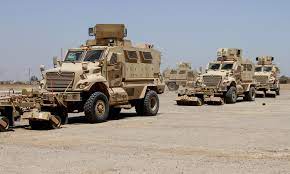For the first time on Friday, the US announced that it would provide Ukraine with Scan Eagle surveillance drones, mine-resistant vehicles, anti-armor ammunition, and howitzer artillery in order to aid Ukrainian forces in regaining lost ground and mounting a counteroffensive against Russian invaders.
According to a senior defense official, a fresh $775 million aid package will include 15 Scan Eagles, 40 MRAPs with mine-clearing rollers, and 2,000 anti-armor rounds to enable Ukraine troops to advance in the south and east, where Russian forces have planted mines. According to the official, as the battle drags on, the U.S. wants to assist in forming and equipping the Ukrainian military of the future.
This most recent assistance comes as Russia’s conflict with Ukraine approaches its halfway point. Since the start of the Biden administration, the US has provided Ukraine with over $10.6 billion in military assistance. Since August 2021, the Pentagon has given Ukraine items from Defense Department inventories 19 times.
Although the United States has previously sent howitzer ammunition, this is the first time it will also supply 16 of the weapon systems. 1,500 anti-tank missiles, 1,000 javelin missiles, and an unspecified number of high-speed, anti-radiation or HARM missiles that aim at radar systems are also included in the aid package. Various precision artillery weapons have been used effectively by Ukrainian forces to fend off Russian forces and retake territory from Moscow.
According to guidelines established by the Defense Department, the defense official informed reporters about the new weapons assistance while maintaining his or her anonymity.
Russia has focused on taking control of the Donbas region in eastern Ukraine for the majority of the last four months of the conflict. Pro-Moscow separatists have been in control of some of this area as self-declared republics for the past eight years.
As Ukraine intensifies its attacks on the Ukrainian peninsula of Crimea, which is on the Black Sea, Russian forces have made some small but significant successes in the east but have also been forced on the back foot in other areas. Moscow assumed control of the Russian-occupied territories in 2014. Last week’s strikes at a facility in Crimea reportedly destroyed nine Russian jets, demonstrating the Ukrainians’ ability to strike far behind enemy lines.
The attack on facilities in Crimea, which the U.S. and its NATO allies have encouraged, has prompted a warning from Russian authorities that it could draw America further into the fight.
According to a Western diplomat, the war is effectively at a standstill, with neither side able to launch significant offensives. The officer, who requested anonymity to discuss military evaluations, claimed that the campaign’s overall pace has slowed in part because both sides understand that “this is a marathon, not a sprint, and that expenditure rates and preserving their munitions is crucial.”
However, according to U.S. and Western officials, Ukraine has been able to conduct successful attacks far behind Russian battle lines, which is damaging the morale and undermining Moscow’s soldiers’ command and control and logistics support.
While Ukrainian troops haven’t been able to regain much ground, the U.S. official claimed they have seriously weakened Russian positions in a number of locations.
Fighting-control initiatives have also persisted. The president of Ukraine, Volodymyr Zelensky, and the leader of Turkey met with the head of the United Nations on Thursday in western Ukraine. They talked about a variety of topics, such as prisoner swaps and a move to invite U.N. nuclear energy specialists to the southern Ukrainian nuclear reactor in Zaporizhzhia.
The complex has been under Russian control ever since the invasion started on February 24 and has been the site of several explosions. International apprehensions about a catastrophe on the continent are increased as Kyiv and Moscow accuse one another of shelling the plant.
Recep Tayyip Erdogan, the president of Turkey, promised to follow up with Vladimir Putin, the president of Russia because most of the issues addressed would require the Kremlin’s approval.

















